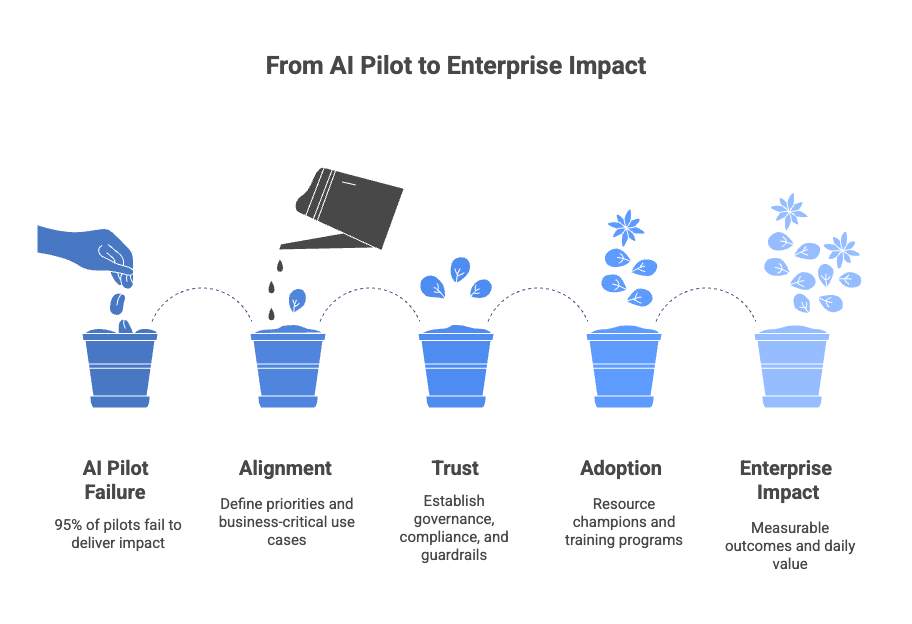Author
Carolyn Gjerde
The Copilot Success Series
This article is the first in our four-part series on making Microsoft 365 Copilot succeed. Across the series, we’ll explore why most AI pilots fail, the playbook of alignment, trust, and adoption, what real success looks like, and a 90-day roadmap to help you scale with confidence.
The Wake-Up Call
Most organizations launch AI pilots with optimism — but the reality is far more sobering. A recent MIT study, covered in Forbes, found that 95% of enterprise AI pilots fail to deliver measurable impact.
That number is a wake-up call. It forces leaders to ask: if so many pilots stall out, what does it take to beat the odds?
The good news: failure isn't inevitable. The organizations that succeed approach AI differently — and that difference starts with leadership.
Why Pilots Struggle to Deliver
AI pilots rarely fail because the technology doesn't work. They fail because organizations approach them in ways that undercut their chances of success.
- Quick optics over real outcomes. Pilots are launched under pressure, but without a clear definition of success, they can't scale.
- Foundations skipped. Governance, compliance, and guardrails are treated as afterthoughts, leaving employees uncertain.
- Value undefined. Without metrics, finance and leadership have no basis for investment.
- Momentum fades. Pilots without sponsorship lose energy, and adoption never takes hold.
These aren't technical problems — they're organizational ones. And that makes them solvable.
Common Pitfalls (and How to Avoid Them)
Even well-intentioned efforts stumble when they fall into familiar traps:
- Chasing "cool" use cases instead of business-critical ones.
Fix: Anchor every pilot to a measurable priority.
- Treating AI like a side project.
Fix: Position pilots within business strategy, not as experiments on the fringe.
- Overpromising, underdelivering.
Fix: Set realistic expectations and measure what matters early.
- Neglecting communication.
Fix: Share purpose, policies, and progress with clarity and consistency.
The Conditions for Copilot Success
Copilot raises the stakes. Once licensed, it's embedded across Outlook, Teams, Word, and Excel. That ubiquity means adoption won't happen by accident. Success depends on creating three conditions:
- Alignment with business priorities. Start with the outcomes that matter most. For example, reduce meeting-prep time, speed up client communications, or streamline reporting.
- Trust through guardrails. Transparent policies on data boundaries and compliance create confidence for employees to explore responsibly.
- Intentional adoption. Champions, training, and role-specific playbooks embed Copilot into daily workflows instead of leaving it as a novelty.
These aren't IT checkboxes. They're leadership levers.
The Leadership Role
Technology enables — but leadership scales. Executives have a unique role to:
- Define the priorities worth solving.
- Sponsor governance visibly, so trust builds early.
- Resource champions and literacy programs as enablers of adoption.
- Ask for and celebrate outcomes, not just usage stats.
When leaders do this, they create the conditions for Copilot to succeed — and for pilots to graduate into enterprise impact.
The Bottom Line
The MIT finding — that 95% of AI pilots fail — is a wake-up call, not a verdict. Copilot doesn't have to be one of them.
With alignment, trust, and adoption in place, and with leaders willing to create the right conditions, Copilot can move from experiment to enterprise capability — delivering measurable impact every day.
👉 Ready to see where your organization stands? Explore Creospark's Copilot Readiness resources and take the first step from pilots to impact.

Want to dive deeper into Copilot strategy and success?
Explore our 4-part Copilot webinar series — packed with expert insights, real-world use cases, and actionable tips to help you lead AI adoption with confidence.
Missed the live session?
No worries, you can watch the full webinar on YouTube and catch up on expert insights, real-world strategies, and practical tips to kickstart your AI journey.

















